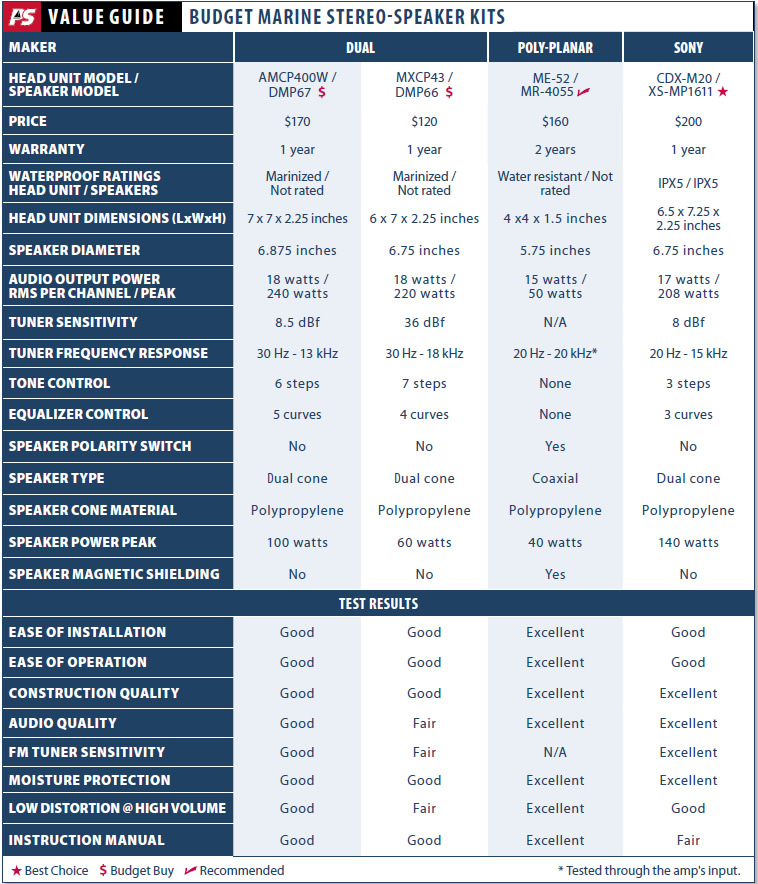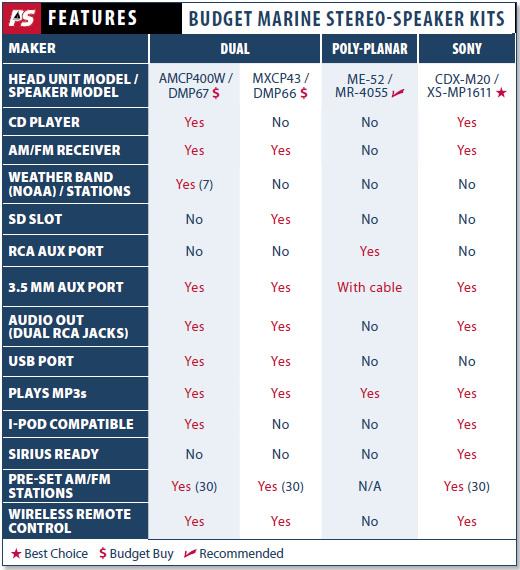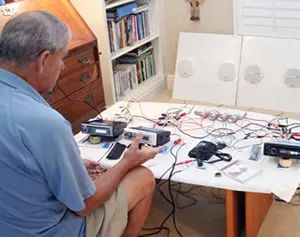
300
When it comes to onboard stereos, most small- and mid-sized boat owners want a simple, affordable sound system with decent audio that can withstand life in the marine environment. To find out what the options are these days for the tight-budget cruiser or trailer-sailor who just wants a basic onboard sound system, Practical Sailor took a look at marine speaker-stereo kits priced under $200. Note that these kits probably will not satisfy the serious audiophile or the techie who is attracted to multi-function displays like the Raymarine e7 (PS, July 2012) that pipe tunes through the same device you navigate by. However, if you are looking for the least expensive marine stereo package that will play those antiquated music-storage media known as CDs as well as your grandson’s iPod, then these may be right up your alley.
To keep the test field within reason, we limited it to marine stereo kits, rather than individual components or packages designed for vehicles and RVs. Car stereos are an affordable option for belowdecks, but many aren’t built to withstand life on a humid, sometimes wet, sailboat. The savings isn’t that great either.
Even among stereos targeted at the marine market, the offerings run the gamut from “waterproof” to “marinized.” Whether you need stereo-speakers rated IPX7 (waterproof to 3 feet) or simply “splashproof” depends on where you intend to install the components. If you’re mounting the housing belowdecks, you likely don’t need to pay extra for a submersible stereo designed for a powerboat center console.
But no matter the installation locale, onboard electronics will certainly last longer if they are made with corrosion-proof materials and the circuit boards are protected by conformal coatings (usually epoxy or urethane resin). Speaker cones should be made of polypropylene or other waterproof material, rather than paper, as most car stereos are.
To get the most life out of an onboard stereo, be sure to remove its faceplate (when possible) and store it ashore. You can also coat exposed connections with a good corrosion-inhibiting spray like TC-11 or CRC Heavy Duty Corrosion Inhibitor (PS, September 2007), but be sure the spray you choose is safe to use on plastics.
What we tested
Practical Sailor evaluated four budget-friendly marine audio packages. Two are made by Dual Electronics Corp.: the Dual AMCP400W and MXCP43. Dual, established in 2003 as a subsidiary of Korea-based Namsung Corp., is one of the largest suppliers of marine stereo and speaker units. We also tested the ME-52 from Poly-Planar, a Maryland-based manufacturer specializing in marine audio systems, and the CDX-M20 from electronics giant Sony Corp.
All but the Poly-Planar are in-dash-style, stereo AM/FM receivers with detachable faceplates and infrared (line of sight) remote controls. The ME-52 is an audio amplifier and has no wireless remote.
All stereos offer two channels of output power (one channel per speaker for balanced, in-stereo sound), and higher quality units may offer four channels. All of the test stereos have four channels, except the Poly-Planar, which has two channels. The test stereos all use 10-amp fuses, and all came with a pair of flush-mount, 6-inch marine speakers and about 12 feet of speaker wire. The four speaker pairs feature water-resistant plastic housings, stainless-steel hardware, and injection-molded polypropylene speaker cones.
The three stereos come with one-year warranties, but the Poly-Planar amplifier comes with a two-year warranty.
How We Tested
Rather than testing the stereos and speakers aboard a boat, Practical Sailor opted to bench test them in a controlled environment to eliminate variations in atmospheric noise pollution (wind, powerboats zooming by, etc.). Our test “lab” was a carpeted room with high ceilings. Speakers were mounted on 2-by-2 plywood baffles and hooked up to their respective head units using the maker-provided wire and being careful to maintain proper polarity. The units were attached to a 12-volt battery through 10-amp fuses and control switches, and a 5-foot AM/FM antenna was inserted in the back of each unit.
To evaluate sound quality and frequency range, testers selected two songs from a playlist recommend by a General Motors audio engineer for testing sound systems: “Hotel California” by the Eagles and Norah Jones’ “Don’t Know Why.” (Find the rest of the playlist at the GM Authority blog, http://goo.gl/z3jY0.) When we proposed spectrum analyzers and test tones to our consulting audio engineer, he rolled his eyes and suggested we “oughta just listen to them.” We took his advice, rounded up five volunteers, and listened to the same songs again and again and again through each stereo’s available inputs using an iPhone, two MP3 players, CDs, and a flash card. The audio rankings were unanimous. (The testers also unanimously agreed they’d be happy not to hear the Eagles or Norah Jones for a while.)
There are a few stereo specs that we did not test for, but we’ve included the maker-supplied ratings in the Value Guide for the more audio-tech-inclined readers who may find them interesting. “Tuner sensitivity” is the ability of a tuner to lock onto a radio signal, keep the channels clean and separated, and reproduce sound without distortion or hissing. Good sensitivity means a better signal-to noise ratio, so the lower the rating number, the better.
“Tuner frequency response” is the ability to reproduce the highs and lows equally, without distortion. The best spec range would be a low first number and a high second number, ie. 20 Hz – 20 kHz.
In these stereos, tone control (bass and treble) is handled in steps. The more steps, the more the available control. The same goes for equalizer control: the more curves, the more control. Equalizer circuits affect tones by changing some frequencies simultaneously. The circuits smoothly shape the sound reproduced by either increasing or decreasing specific frequencies with different curves.
None of the test products are rated as waterproof.
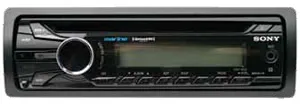
300
Dual AMCP400W
This is a good stereo package that includes a CD player, AM/FM receiver, remote control, and two speakers. The AMCP400W was the only test unit that offers a seven-channel NOAA weather band tuner, a definite bonus.
The faceplate has a 3.5-millimeter auxiliary input and a USB input, both with silicone plugs to protect them from water intrusion. The plugs are connected to the faceplate by short, thin threads to keep them from being lost overboard; however they should still be handled with care. The detachable face includes all the necessary control buttons, but contains no actual switches or electronics. Testers liked this because it meant fewer vulnerable parts in the exposed faceplate.
The AMCP400W will play MP3, WMA, and iTunes files. It is iPod/iPhone compatible and will actually charge iPods and iPhones while they are connected.
Both Dual stereos allow users to pre-set up to 30 radio stations. The LCD display will show 10 characters at a time for names of songs, albums, artists, etc.
Testers noted that the AMCP400W had a slight edge over the MXCP43 in sound quality, but it did not top the Sony or Poly-Planar in that category. It could handle higher volume with less distortion than the other Dual stereo, and the FM tuner was a little clearer.
Bottom line: The AMCP400W performed very well, and since the front faceplate has no electronics, we’re betting it’s more corrosion-resistant (and durable) than its sister stereo. It gets the PS Budget Buy pick for a CD-player equipped speaker-stereo kit under $200.
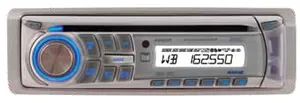
300
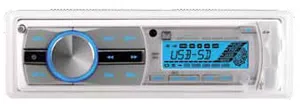
300
Dual MXCP43
The Dual MXCP43 is similar to the AMCP400W package, but it lacks a CD player and weather band channels; however, it does feature a slot for an SD media-storage card and a USB port. It also has the same rated RMS output power as the AMCP400W. It came with audio output cables that have weatherproof caps for easy hook-up to an external power amplifier.
The water-resistant control switches and electronics are contained within the MXCP43’s faceplate, which is connected to the main stereo housing by a nine-pin connector. This setup, compared to the AMCP400W, seems a little more vulnerable to moisture damage over time.
The MXCP43 can play MP3/WMA audio files, has a 3.5-millimeter auxiliary jack, and can play tunes from an SD card or USB thumbdrive, but it is not iPod/iPhone compatible.
Bottom line: If you’re looking for an affordable kit with decent sound—and you don’t want a CD player—then the MXCP43 is worth considering. It gets the PS Budget Buy for a CD-less stereo.

500
Poly-Planar ME-52
Unique in this test group, the Poly-Planar ME-52 is a simple two-channel audio amplifier that is capable of delivering up to 15 watts per channel with excellent frequency response (20 Hz – 20 kHz), from one external audio input. The input can be directly through the provided, shielded RCA patch cables or from the provided weatherproof MP3 flush-mount adapter receptacle and cable. The source can be any external AM/FM tuner, satellite radio, TV, or MP3 player.
It will accept either a line output or a speaker output. The amplifier includes an input level switch (line level or speaker level) that must be set for one or the other. It is located behind a rectangular rubber cover, as is the speaker polarity switch, which helps synchronize the wiring to the speakers, so they are not out of phase. (Out of phase speakers will have degraded stereo affect and poor bass response.)
The unit also comes with an external weatherized volume control and cable for remote control. These could be installed in the cockpit, for instance, while the amplifier is installed in the cabin. None of the other product’s remotes would allow helm-control of a cabin-mounted stereo. If the external volume control is not used, the amplifier has a screw-driver adjustable volume control.
The ME-52 does not include a CD player, AM/FM receiver, or USB port; however, it does have one RCA auxiliary input port.
The coaxial speakers in this package are excellent quality and offered top-rate sound quality. They were the only ones in the group with magnetic shielding, making them better candidates for mounting near a compass or other sensitive electronics.
Bottom line: The ME-52 needs external inputs and controls, but it is an excellent weatherproof stereo amplifier and gets PS’s Recommendation.
Sony CXS-M2016
The Sony CXS-M2016 CD-player/receiver and speaker package features the company’s Digital Clarity Tuner and Dynamic Reality Amplifier, which is capable of 52 watts peak per channel, but its rated RMS is 17 watts. Testers noted its quality construction and good performance.
The Sony’s CD-player opening has a rubber splash-proof gasket for protection and its auxiliary input comes with an untethered silicone plug. The Sony does not offer weather band, but it plays MP3 files, is iPod compatible, and has an AM/FM receiver with 30 selectable pre-set stations. The RDS-compatible display means that it will show the now-playing artist and song on select FM stations. The Sony was the only satellite-capable test unit; it will connect to Sirius XM radio.
The CXS-M2016 was the only package with speakers carrying a specific water-resistance rating. The two 6.5-inch, 40-watt speakers are rated to handle water jets projected from any direction. This does not mean they are waterproof, but they are water resistant enough to be mounted in a cabin or in a protected place in a cockpit. The stereo offers further environmental protection with the UV-resistant coating on its faceplate and its conformal-coated circuit boards, which resist moisture.
Bottom line: The Sony’s functional programming is extensive, and it appears more rugged and more marinized than the other test products. To the subjective ears of all PS testers, the Sony’s sound was a little richer, deeper, and more brilliant. Although it’s the most expensive unit we tested, it gets the PS Best Choice in this test field.
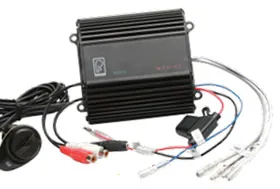
280
Conclusions
All of the test kits worked well, performed as specified, and were fairly easy to install and hookup. The four kits are all good values, in our opinion, but they will not suit audio snobs. In this field, you get what you pay for.
Practical Sailor can recommend all four of the tested packages, but the Sony CDX-M20 package gets the Best Choice pick for its top-notch construction quality, intuitive controls and programming, multiple features, and comparatively excellent sound quality.
Unless you have a great stack of CDs that you really love, a stereo without a CD player may be your best option. No CD player means no large opening in the faceplate and fewer moving parts that can wear out and cause problems.
The simplest and quickest unit to install, the Poly-Planar ME-52 has good audio response, is mid-priced, and is made with quality materials. We recommend it for those looking to add an amp to an existing system or for those who don’t need the multiple input options the stereos offer.
Of the two Dual test units, PS testers preferred the Dual AMCP400W. Priced just $50 more than the MXCP43, it offers desirable features that its sister stereo does not, namely the CD player, weather band, and a slightly better sound quality. It gets the PS Budget Buy for its category.
If a weather band and CD player are not on your list of must-have options, save the $50 and go for the less expensive MXCP43. It offers an SD slot and decent FM reception, and so it gets the Budget Buy pick for its category.
At presstime, summer sales were in full swing, and all of the test products had been marked down. Prices change continuously, so check online and local retailers to find the most current prices.
Stay Tuned
If you’re an audiophile looking for more power, more volume, and more bass than these four stereos can produce—and are willing to spend a little more to get bigger amps, bigger coaxial speakers, etc.—then stay tuned for our upcoming report on mid-priced and high-end marine stereos that deliver just that.
